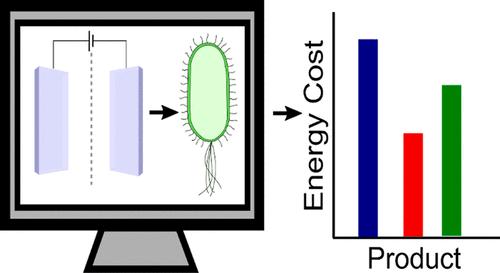Cascading the Electrochemical Reduction of CO2 with Bioprocesses for the Production of Reduced-Carbon-Intensity Chemicals
IF 7.3
1区 化学
Q1 CHEMISTRY, MULTIDISCIPLINARY
引用次数: 0
Abstract
Electrochemical reduction of CO2 (eCO2R) offers a route to one- and two-carbon (C1/C2) intermediates, and these can serve as lower-carbon-intensity feedstocks for the biobased synthesis of C3+ products. We evaluate the energy inputs for ∼1000 cases of the integrated system, considering 9 intermediates and 50+ bioproducts. The most energetically compelling options include aerobic bioconversion of C2 intermediates or methanol to more oxidized products. As an intermediate, ethanol provides the highest overall bioproduction mass yield among candidate substrates, with over 25% of the products having a mass yield greater than one. For fuels, the anaerobic bioconversion of methanol and CO each appear promising, with energy inputs in the range of 40–60 GJ/ton. We find that the recycling of CO2 generated during bioproduction is optimal when CO2 capture costs for eCO2R exceed the separation costs of the bioreactor gas stream. Overall, this analysis points to privileged {intermediate, product} pairings in such integrated systems.

电化学还原二氧化碳与生物工艺级联生产低碳强度化学品
二氧化碳的电化学还原(eCO2R)为一碳和二碳(C1/C2)中间体提供了一条途径,这些中间体可以作为生物基合成C3+产品的低碳强度原料。我们评估了集成系统约1000个案例的能量输入,考虑了9种中间体和50多种生物制品。最具能量吸引力的选择包括C2中间体或甲醇的好氧生物转化为更氧化的产物。作为中间体,乙醇在候选底物中提供了最高的总体生物生产质量产率,超过25%的产品质量产率大于1。在燃料方面,甲醇和一氧化碳的厌氧生物转化似乎都很有前景,能量输入在40-60吉焦/吨之间。我们发现,当eCO2R的二氧化碳捕获成本超过生物反应器气流的分离成本时,生物生产过程中产生的二氧化碳的回收是最佳的。总的来说,这一分析指出了这种集成系统中的特权{中间产品}配对。
本文章由计算机程序翻译,如有差异,请以英文原文为准。
求助全文
约1分钟内获得全文
求助全文
来源期刊

ACS Sustainable Chemistry & Engineering
CHEMISTRY, MULTIDISCIPLINARY-ENGINEERING, CHEMICAL
CiteScore
13.80
自引率
4.80%
发文量
1470
审稿时长
1.7 months
期刊介绍:
ACS Sustainable Chemistry & Engineering is a prestigious weekly peer-reviewed scientific journal published by the American Chemical Society. Dedicated to advancing the principles of green chemistry and green engineering, it covers a wide array of research topics including green chemistry, green engineering, biomass, alternative energy, and life cycle assessment.
The journal welcomes submissions in various formats, including Letters, Articles, Features, and Perspectives (Reviews), that address the challenges of sustainability in the chemical enterprise and contribute to the advancement of sustainable practices. Join us in shaping the future of sustainable chemistry and engineering.
 求助内容:
求助内容: 应助结果提醒方式:
应助结果提醒方式:


